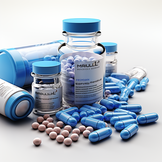Can viagra/sildenafil treat premature ejaculation?
- Introduction to Viagra/Sildenafil and Premature Ejaculation
- Key Studies on Sildenafil's Effectiveness in Treating PE
- Sildenafil's Impact on Postejaculatory Refractory Time
- Ongoing Research and the Need for More Conclusive Studies
- Mechanism of Action of Sildenafil in Treating PE
- FDA Approval for Erectile Dysfunction and Potential Off-Labeled Uses
- Combining Sildenafil with Other Treatments
- Safety Considerations and Consulting a Healthcare Provider
- Conclusion

Introduction to Viagra/Sildenafil and Premature Ejaculation
Viagra, the brand name for the drug sildenafil, is most commonly recognized as a treatment for erectile dysfunction. It operates by relaxing the blood vessels and improving blood flow to certain areas of the body, primarily the penis. However, another sexual health condition has caught the attention of researchers and physicians alike: premature ejaculation (PE). PE is defined as ejaculation that happens sooner than a man or his partner would want during sex. The question of whether sildenafil could serve as a viable treatment for this condition has become a topic of interest.
Key Studies on Sildenafil's Effectiveness in Treating PE
Wang and Ralph's multicentric study in 2007 was a significant investigation in this domain. The researchers aimed to assess the effectiveness and safety of sildenafil in treating men with PE. Their findings suggested that sildenafil could significantly increase the intravaginal ejaculatory latency time (IELT), thus improving the sexual satisfaction of both the patients and their partners.
When comparing sildenafil with paroxetine, an antidepressant already known to delay ejaculation, studies have shown varied results. Some suggest that sildenafil is equally effective, while others advocate for paroxetine's superior performance. However, it's important to note that these studies often do not consider factors like the female partner's sexual function and possible drug interactions, which can significantly influence the outcomes.
Sildenafil's Impact on Postejaculatory Refractory Time
A compelling feature of sildenafil in relation to PE is its impact on the postejaculatory refractory time, the recovery phase after orgasm during which it is physiologically impossible for a man to have additional orgasms. Evidence suggests that sildenafil may shorten this period, allowing for quicker recovery and repeated sexual encounters, which can be beneficial for individuals dealing with PE.
Ongoing Research and the Need for More Conclusive Studies
Despite the promising findings, the evidence remains inconclusive. Much more research is needed to solidify the potential role of sildenafil in managing PE. More randomized controlled trials, as well as long-term follow-up studies, are required to assess the efficacy, safety, and acceptability of sildenafil for this use.
Mechanism of Action of Sildenafil in Treating PE
The exact mechanism of action of sildenafil in treating PE is not fully understood. However, it's thought to work by enhancing the effect of nitric oxide, which in turn relaxes the muscles in the penis and increases blood flow. This can help a man sustain an erection after ejaculation and potentially reduce anxiety related to sexual performance, which is often a contributing factor to PE.
FDA Approval for Erectile Dysfunction and Potential Off-Labeled Uses
As of my knowledge cutoff in September 2021, the U.S. Food and Drug Administration (FDA) has approved sildenafil only for the treatment of erectile dysfunction. However, physicians may prescribe it off-label for PE, based on the patient's specific circumstances and the provider's clinical judgment.
Combining Sildenafil with Other Treatments
Sildenafil is sometimes used in combination with other treatments to manage PE. For instance, it may be used along with sensitivity-reducing creams that can decrease penile sensation and prolong the time to ejaculation.
Safety Considerations and Consulting a Healthcare Provider
As with any medication, sildenafil carries potential side effects, which can include headaches, flushing, upset stomach, abnormal vision, and, in rare cases, more serious effects like sudden vision loss or heart attack symptoms. It's crucial to consult a healthcare provider before taking sildenafil for PE to discuss potential risks and benefits.
Furthermore, the dosage of sildenafil for PE is not standardized and should be determined by a healthcare provider based on individual need. The decision between sildenafil and other medications, such as tadalafil, for treating PE will depend on the individual's medical history, current health status, and the specific symptoms of PE they are experiencing.
Conclusion
In conclusion, while sildenafil has shown promise in treating PE, further research is needed to confirm its efficacy and safety for this use.Individuals considering sildenafil for PE should consult with a healthcare provider to discuss potential benefits and risks.It's also important to remember that PE is a common issue, and a range of treatment options are available, not just medication.
These include behavioral techniques, therapy, and other medical treatments.



